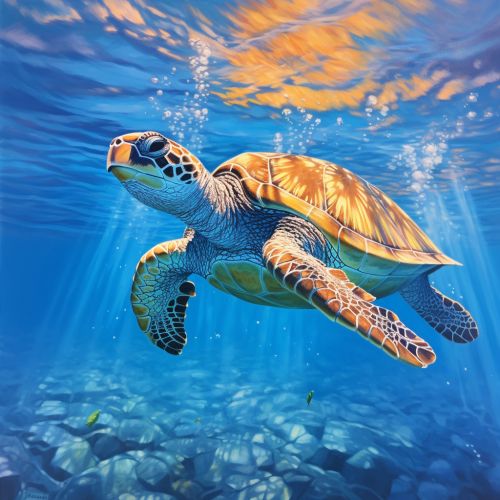Sea Turtle Migration
Introduction
Sea turtle migration refers to the long-distance oceanic journeys undertaken by sea turtles as part of their life cycle. These migrations, which can span thousands of kilometers, are a remarkable aspect of sea turtle biology and have been the subject of extensive scientific study.
Biology of Sea Turtles
Sea turtles are a group of reptiles that have adapted to a fully marine life. They are characterized by their streamlined bodies and large flippers, adaptations that enable them to swim efficiently in the ocean. There are seven species of sea turtles: the green, loggerhead, Kemp's ridley, olive ridley, hawksbill, flatback, and leatherback.


Migration Patterns
Sea turtles are known for their extensive migration patterns, which are among the longest in the animal kingdom. These patterns are complex and vary among species, populations, and individuals. However, they generally involve movements between feeding grounds and nesting sites.
Feeding Grounds
Sea turtles spend most of their lives in feeding grounds, which are typically productive coastal or offshore areas where food resources are abundant. The choice of feeding grounds is influenced by a variety of factors, including food availability, habitat characteristics, and environmental conditions.
Nesting Sites
Nesting sites are specific locations where female sea turtles come ashore to lay their eggs. These sites are typically sandy beaches and are often the same places where the turtles themselves hatched. The process of returning to one's place of birth to reproduce is known as natal homing.
Mechanisms of Migration
The mechanisms by which sea turtles navigate during their migrations are not fully understood, but are believed to involve a combination of innate and learned behaviors, as well as environmental cues.
Sea turtles are thought to use a variety of cues to orient themselves and navigate during their migrations. These include geomagnetic cues, celestial cues, and oceanic currents.
Genetic Influence
Genetic factors may also play a role in sea turtle migration. Studies have shown that migratory behavior can vary among different populations of the same species, suggesting a genetic component to migration patterns.
Impacts of Migration
Migration has significant impacts on the life history and conservation of sea turtles. It influences their distribution, reproduction, and survival, and exposes them to a variety of threats.
Distribution and Reproduction
Migration allows sea turtles to exploit different habitats at different stages of their life cycle, which can enhance their survival and reproductive success. However, it also means that they are dependent on multiple habitats, which can make them vulnerable to habitat loss and degradation.
Threats
During their migrations, sea turtles face numerous threats, including predation, bycatch in fisheries, marine pollution, and climate change. These threats can have significant impacts on sea turtle populations and are a major focus of conservation efforts.
Conservation
Conservation of sea turtles is a global concern, given their ecological importance and the threats they face. Efforts to conserve sea turtles and their habitats include protected areas, fisheries management, pollution control, and climate change mitigation.
